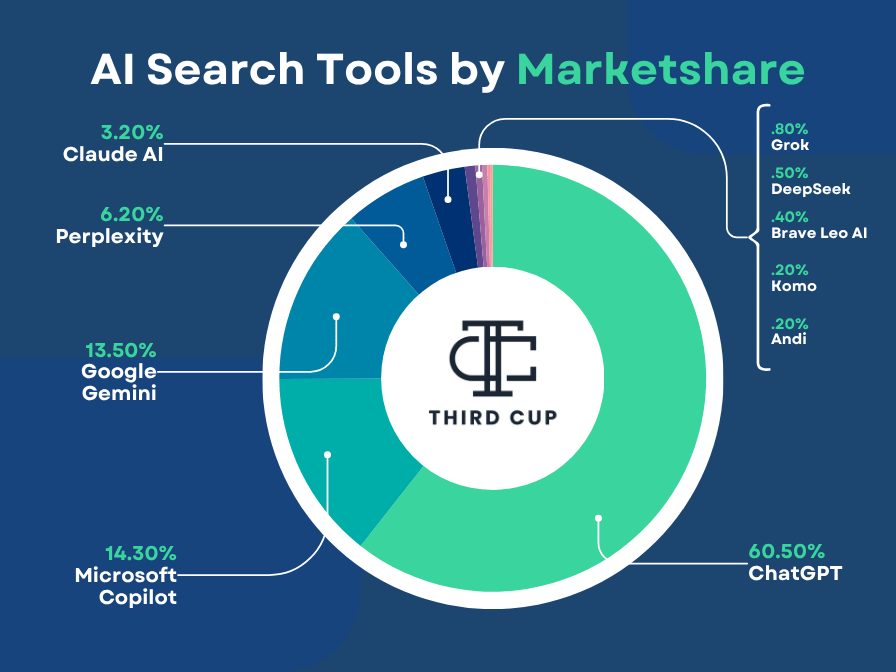The search landscape is undergoing a seismic shift. While Google still dominates with billions of daily queries, artificial intelligence-powered search tools like ChatGPT, Perplexity, and Claude are carving out their own space in how people discover information. For businesses, this means the traditional playbook of search engine optimization is expanding—and those who adapt early will capture the most opportunity.
The Current State of AI vs. Traditional Search
Despite the buzz around AI search tools, the numbers tell a nuanced story. Google continues to reign supreme, maintaining its position as the world’s primary search engine. Recent research indicates that Google still receives approximately 373 times more searches than ChatGPT, with traditional search engines accounting for over 98% of the search market.
However, the trend lines reveal a different narrative. ChatGPT usage surged 44% month-over-month through late 2024, while Perplexity saw even more dramatic growth at 71% monthly increases. Most tellingly, Perplexity experienced a staggering 524% surge in usage throughout 2024, with sessions per user growing dramatically. Some analysts predict ChatGPT could capture 1% of the search market by 2025—a seemingly small number that represents millions of daily queries.
The user behavior patterns are equally revealing. Google users perform approximately 200 searches per month on average, while Perplexity users conduct around 15 searches monthly. This suggests AI search tools are being used more selectively for complex, research-oriented queries rather than quick informational lookups.
Ranking of Most Used AI Search Tools (July 2025)
Based on the latest market share data, here’s how the major AI search and chat platforms stack up:
Top 10 AI Search Tools by Market Share:
-
-
-
- ChatGPT – 60.50% market share (7% quarterly growth). The undisputed leader in AI search, though slowly losing market share to competitors
- Microsoft Copilot – 14.30% market share (6% quarterly growth). Leverages GPT-4 technology integrated with Microsoft’s ecosystem.
- Google Gemini – 13.50% market share (8% quarterly growth). Google’s AI assistant is showing steady growth despite a market share decline from its 2024 peak.
- Perplexity – 6.20% market share (10% quarterly growth). The dedicated AI search engine with the highest growth rate among major players
- Claude AI – 3.20% market share (14% quarterly growth). The fastest-growing platform, particularly popular with business users
- Grok (X.ai) – 0.80% market share (6% quarterly growth)X’s AI search engine with modest but steady adoption
- DeepSeek – 0.50% market share (10% quarterly growth), Emerging player with strong growth momentum
- Brave Leo AI – 0.40% market share (6% quarterly growth), Privacy-focused alternative gaining traction
- Komo – 0.20% market share (7% quarterly growth)Specialized link-surfacing AI search engine
- Andi – 0.20% market share (5% quarterly growth)Simplicity-focused search alternative
-
-

Key Market Trends:
-
- ChatGPT’s dominance is slowly eroding, dropping from 76.4% market share in January 2024 to 60.50% in July 2025
- Specialized AI search tools like Perplexity and Claude are gaining ground with double-digit growth rates
- The market is fragmenting, with users experimenting across multiple AI platforms for different use cases
Why AI Search Matters for Your Business
The significance of AI search extends far beyond raw usage numbers. These platforms attract users seeking in-depth, authoritative answers to complex questions—exactly the audience businesses want to reach during crucial decision-making moments.
Unlike traditional search results that present a list of links, AI search tools provide direct answers with source citations. When your content gets cited by ChatGPT or featured in a Perplexity response, you’re not just getting a backlink—you’re being positioned as a trusted authority on the topic. This can drive highly qualified traffic to your website from users who are already primed by the AI’s endorsement.
Furthermore, AI search users tend to ask more conversational, long-tail queries. Instead of searching “best CRM software,” they might ask, “What CRM software works best for a 50-person B2B company with remote sales teams?” This shift toward natural language queries opens new opportunities for businesses to capture traffic for precise, valuable search terms.
How Businesses Must Adapt: The New AI SEO Playbook
1. Focus on Authority and Credibility
AI search engines heavily prioritize content from authoritative sources. Unlike traditional SEO, where you might rank through technical optimization alone, AI platforms evaluate the credibility of your domain, the depth of your expertise, and the quality of your citations.
Action Steps:
-
- Publish comprehensive, well-researched content that demonstrates deep subject matter expertise
- Include proper citations and references to reputable sources
- Build domain authority through consistent, high-quality content publication
- Establish thought leadership through original research, case studies, and industry insights
2. Optimize for Conversational Queries
AI search excels at understanding natural language. Users ask complete questions rather than typing fragmented keywords, which means your content strategy needs to shift accordingly.
Action Steps:
-
- Create FAQ-style content that directly answers common customer questions
- Use natural language in your headings and subheadings
- Write in a conversational tone that mirrors how people actually speak
- Target long-tail keywords that reflect how users ask questions verbally
3. Create Citation-Worthy Content
Since AI search tools cite their sources, your content needs to be structured in a way that makes it easy for AI to extract and attribute information.
Action Steps:
-
- Use clear, descriptive headings that summarize key points
- Include statistics, data, and factual information that AI can cite
- Structure content with bullet points, numbered lists, and clear sections
- Add unique research, surveys, or proprietary data that other sources can’t provide
4. Invest in Visual Content
Perplexity, in particular, frequently includes images, charts, and diagrams in its responses. Visual content significantly increases your chances of being featured.
Action Steps:
-
- Create original charts, graphs, and infographics that illustrate your key points
- Optimize images with descriptive alt text and file names
- Develop unique visual content that complements your written material
- Consider creating video content for platforms like YouTube, which AI tools often reference
5. Maintain Fresh, Current Content
AI search tools favor up-to-date information, making content freshness more critical than ever.
Action Steps:
-
- Regularly update existing content with new data and insights
- Monitor industry trends and update your content to reflect current best practices
- Add publication and update dates to your content
- Create content around trending topics in your industry
6. Optimize for Multiple AI Platforms
Different AI search tools have varying preferences and algorithms. A diversified approach increases your chances of visibility across platforms.
Action Steps:
-
- Monitor which AI platforms are citing your content using insightful analytics tools like RankPrompt, Keyword.com, Hall, and Otterly.AI.
- Adapt your content strategy based on which platforms drive the most valuable traffic.
- Study the types of content each platform tends to feature.
- Create content specifically designed for different AI search behaviors.
Measuring Success in the AI Search Era
Traditional SEO metrics like keyword rankings become less relevant in AI search. Instead, focus on:
-
- Direct Traffic Spikes: Monitor for traffic increases following AI citations of your content
- Referral Traffic: Track visits from AI platforms when they provide direct links
- Brand Mention Tracking: Use tools to monitor when your brand or content gets mentioned in AI responses
- Authority Metrics: Focus on domain authority, expert recognition, and industry citations
- Engagement Quality: Measure time on site, pages per session, and conversion rates from AI-driven traffic
The Strategic Imperative
The businesses that will thrive in the AI search era are those that view this shift as an opportunity rather than a threat. While Google isn’t disappearing anytime soon, the diversification of search behavior creates new opportunities for reaching customers.
Smart businesses are already implementing dual optimization strategies—maintaining their traditional SEO efforts while simultaneously optimizing for AI search platforms. This approach ensures they capture traffic from both established search behaviors and emerging AI-driven queries.
The key insight is that AI search optimization isn’t fundamentally different from good SEO—it’s an evolution that rewards the same principles of authority, relevance, and user value, but with greater emphasis on depth, credibility, and natural language optimization.
Looking Ahead
As AI search tools continue to evolve and gain market share, the businesses that adapt early will establish competitive advantages that compound over time. The transition period we’re currently experiencing represents a unique opportunity to gain visibility on these platforms before they become as competitive as traditional search engines.
The future of search is multimodal, conversational, and AI-powered. The question isn’t whether your business should adapt to this reality—it’s how quickly you can begin capturing the opportunities it creates.
Start by auditing your current content through the lens of AI search optimization. Which pieces could serve as authoritative sources for AI citations? What questions are your customers asking that aren’t well-addressed by existing content? How can you position your expertise to be discoverable by both traditional search engines and AI platforms?
The search landscape is evolving rapidly, but the businesses that commit to providing genuine value, demonstrating clear expertise, and optimizing for how people naturally ask questions will find success across all search platforms—traditional and AI-powered alike.


